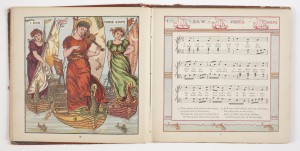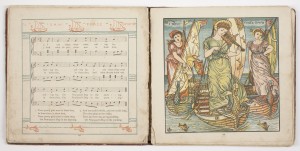
Nineteenth-century American publisher McLoughlin Brothers pioneered the use of chromolithography in the production of color picture books starting in the 1860s. Until that point, most children’s books were illustrated with wood engravings that were locked into the printing press form along with set type. Coloring these images generally entailed using hand-colored stencils or employing a system of printing with wood blocks inked with colors–a system that was labor intensive and frustrating, due to the wood block’s tendency to wear down over time. By the early 1860s, ephemera printers discovered how to easily transfer wood-engraved images to more durable lithographic stones that could be mounted onto steam presses for mass production. McLoughlin Brothers was among the earliest American children’s book publishers to experiment with the new chromolithographic technology. By the 1870s, McLoughlin Brothers also developed a notorious reputation as a publisher of unauthorized reissues of British picture books, including those issued by English picture book publisher Frederick Warne & Co., whose books were imported from London by Scribner, Welford, and Armstrong–a branch of Charles Scribner and Company. It is probably no accident that a vitriolic letter penned by English illustrator Walter Crane attacking the McLoughlin Bros.’ gaudy and unauthorized reproduction of his Baby’s Opera appeared in the September 1877 issue of Scribner’s Monthly.

What was Crane complaining about? To the right is the illustration and music for “I saw Three Ships” published in London George Routledge & Sons; the illustrations are engraved on wood and printed in color by Crane’s collaborator Sir Edmund Evans. It is an elegant piece of color relief printing; note the muted shades of yellow, violet, and peach worn by the three angels. In the hands of McLoughlin Brothers, Evans’ wood engravings are turned into chromolithographs, and the colors are robust shades of purple, orange, and green; the pale tint of the angels skin in Evans’ hands becomes a more life-like hue in the McLoughlin version, giving the angels the look of actual young girls dressed like angels. Both versions are beautiful, but they are an apple and an orange, and at a retail cost of 75 cents, the McLoughlin version was clearly cheaper to produce and purchase; the cost of the Routledge edition was probably well over a dollar and possibly double the cost of the McLoughlin copy.
Not surprisingly, Charles Scribner II became an ardent advocate of an international copyright law. But until the American copyright law of 1891 guaranteed some rights for foreign holders, McLoughlin Bros. reigned as a prolific publisher of picture book pirate editions. Then just as now, the legal copyright fight over the intellectual and artistic ownership of images continues.
A side note: The words to the song are a bit different from the currently known carol: “I saw three ships come sailing by, Sailing by, Sailing by, I saw three ships come sailing by, On New Year’s Day in the morning.” Happy New Year!
To learn more about the development of chromolithography, take a look at Boston Lithography, 1825-1880 by Sally Pierce and Catharina Slautterback (Boston: Boston Athenaeum, 1991).
Editor’s Note: This post is taken from a talk on “McLoughlin Brothers: Nineteenth-Century Entrepreneurs and Innovators of the American Picture Book” that will be held at Koret Auditorium, San Francisco Public Library tomorrow, Saturday, Jan. 5, at 2 p.m.

I find it interesting that the McLoughlin brothers book reversed the colors on two of the dresses.Instead of just brightening the colors, they redesigned them somewhat as well.
I’m looking forward to your talk! How interesting the stories behind the stories are.Keep up the good work and thanks for sharing.